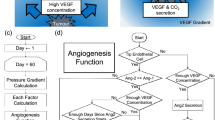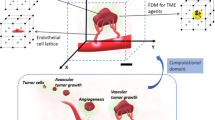Abstract
The present work formulates and analyzes the inhibitory effect of anti-angiogenic factor angiostatin excreted by the primary tumor on metastatic tumor angiogenesis, blood perfusion, and interstitial fluid flow in the tumor microenvironment by means of a numerical experiment. The simulation results demonstrate that angiostatin has an obvious impact on the morphology, growth rate, and the number of branches of microvascular network inside and outside the metastatic tumor, and angiostatin has the capacity to regulate and inhibit the formation of new blood vessels. Heterogeneous blood perfusion, widespread interstitial hypertension, and low convection within the metastatic tumor have obviously improved under the inhibitory effect of angiostatin, which are consistent with physiological observed facts. The simulation results may provide beneficial information and theoretical models for clinical research of anti-angiogenic therapy strategies.






Similar content being viewed by others
References
Alarcón, T., Owen, M. R., Byrne, H. M., & Maini, P. K. (2006). Multiscale modelling of tumour growth and therapy: the influence of vessel normalisation on chemotherapy. Comput. Math. Methods Med., 7(2–3), 85–119.
Anderson, A. R. A., & Chaplain, M. A. J. (1998). Continuous and discrete mathematical models of tumor-induced angiogenesis. Bull. Math. Biol., 60, 857–900.
Anderson, A. R. A., & Chaplain, M. A. J. (2000). A gradient-driven mathematical model of antiangiogenesis. Math. Comput. Model., 32, 1141–1152.
Aubert, M., Chaplain, M. A. J., McDougall, S. R., Devlin, A., & Mitchell, C. A. (2011). A continuum mathematical model of the developing murine retinal vasculature. Bull. Math. Biol. doi:10.1007/s11538-011-9631-y.
Baxter, L. T., & Jain, R. K. (1989). Transport of fluid and macromolecules in tumors I. Role of interstitial pressure and convection. Microvasc. Res., 37, 77–104.
Cai, Y., Wu, J., Gulnan, K., Zhang, H., Cao, J., Xu, S., Long, Q., & Collons, M.W. (2009). Numerical simulation of solid tumor angiogenesis with Endostatin treatment: a combined analysis of inhibiting effect of anti-angiogenic factor and micro mechanical environment of extracellular matrix. Appl. Math. Mech., 30(10), 1247–1254.
Folkman, J. (1971). Tumor angiogenesis: therapeutic implications. N. Engl. J. Med., 285(10), 1182–1186.
Fukumura, D., & Jain, R. K. (2007). Tumor microvasculature and microenvironment: targets for anti-angiogenesis and normalization. Microvasc. Res., 74, 72–84.
Jain, R. K., Tong, R. T., & Munn, L. L. (2007). Effect of vascular normalization by antiangiogenic therapy on inerstitial hypertension, peritumor edema, and lymphatic metastasis: insights from a mathematical model. Cancer Res., 67(6), 2729–2735.
Konjevic, G., & Stankovic, S. (2006). Matrix metalloproteinases in the process of invasion and metastasis of breast cancer. Arch. Oncol., 14(3–4), 136–140.
Kuszyk, B. S., Corl, F. M., Franano, F. N., Bluemke, D. A., Hofmann, L. V., Fortman, B. J., & Fishman, E. K. (2001). Tumor transport physiology: Implications for imaging and imaging-guided therapy. Am. J. of Radiol., 177, 747–753.
Madu, C. O., & Lu, Y. (2009). Tumor microvasculature and microenvironment: therapeutic targets for inhibition of tumor angiogenesis and metastasis. In Pharmaceutical perspectives of cancer therapeutics. New York: Springer.
Maggelakis, S. A. (1996). The effects of tumor angiogenesis factor (TAF) and tumor inhibitor factors (TIFs) on tumor vascularization: a mathematical model. Math. Comput. Model., 23(6), 121–133.
McDougall, S. R., Anderson, A. R. A., Chaplain, M. A. J., & Sherratt, J. A. (2002). Mathematical modeling of flow through vascular network: implications for tumor-induced angiogenesis and chemotherapy strategies. Bull. Math. Biol., 64, 673–702.
O’Reilly, M. S., Holmgren, L., Shing, Y., Chen, C., Rosenthal, R. A., Moses, M., Lane, W. S., Cao, Y. H., Sage, E. H., & Folkman, J. (1994). Angiostatin: a novel angiogenesis inhibitor that mediates the suppression of metastases by a Lewis lung carcinoma. Cell., 79(2), 315–328.
Sim, B. K. L., O’Reilly, M. S., Liang, H., Fortier, A. H., He, W., Madsen, J. W., Lapcevich, R., & Nacy, C. A. (1997). A recombinant human angiostatin protein inhibits experimental primary and metastatic cancer. Cancer Res., 57, 1329–1334.
Soff, G. A. (2000). Angiostatin and angiostatin-related proteins. Cancer Metastasis Rev., 19, 97–107.
Stephanou, A., McDougall, S. R., Anderson, A. R. A., & Chaplain, M. A. J. (2005). Mathematical modelling of flow in 2D and 3D vascular networks: applications to anti-angiogenic and chemotherapeutic drug strategies. Math. Comput. Model., 41, 1137–1156.
Tao, K. S., Dou, K. F., & Wu, X. A. (2004). Expression of angiostatin cDNA in human hepatocellular carcinoma cell line SMMC-7721 and its effect on implanted carcinoma in nude mice. World J. Gastroenterol, 10, 1421–1424.
Tee, D., & DiStefano, J. (2004). Simulation of tumor-induced angiogenesis and its response to anti-angiogenic drug treatment: mode of drug delivery and clearance rate dependencies. J. Cancer Res. Clin. Oncol., 130, 15–24.
Wu, J., Ding, Z., Cai, Y., Xu, S., Zhao, G., & Quan, L. (2011). Simulation of tumor microvasculature and microenvironment response to anti-angiogenic treatment by angiostatin and endostatin. Appl. Math. Mech., 32(4), 437–448.
Zhao, G., Gao, H., Wu, J., Xu, S., Collons, M. W., Long, Q., Carola, K., & Padhani, A. R. (2006). 2D numerical simulation of effect of antiangiogenic factors Angiostatin and Endostatin on tumor-induced angiogenesis. J. Med. Biomech., 21(4), 272–279.
Zheng, X., Wise, S. M., & Cristini, V. (2005). Nonlinear simulation of tumor necrosis, neo-vascularization and tissue invasion via an adaptive finite-element/level-set method. Bull. Math. Biol., 67, 211–259.
Acknowledgements
This research has been supported by a grant provided by the National Natural Science Foundation of China (51106099), Innovation Program of Shanghai Municipal Education Commission (12YZ109) and National Natural Science Foundation of China Cultivate project (12XGQ04).
Author information
Authors and Affiliations
Corresponding author
Rights and permissions
About this article
Cite this article
Zhao, G., Yan, W., Chen, E. et al. Numerical Simulation of the Inhibitory Effect of Angiostatin on Metastatic Tumor Angiogenesis and Microenvironment. Bull Math Biol 75, 274–287 (2013). https://doi.org/10.1007/s11538-012-9805-2
Received:
Accepted:
Published:
Issue Date:
DOI: https://doi.org/10.1007/s11538-012-9805-2




